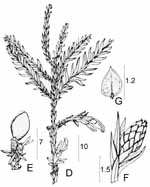 "D. part of branchlet with leaves and poorly developed fruits, E. ripe fruit, F. male cone, G. microsporophyll" (1). | Dacrycarpus imbricatus var. robustus de Laubenfels 1969Common NamesBorneo: pierur (Kelabit, on Sarawak); Philippines: tupi (Cotabato, on Mindanao) (2); New Guinea: apé (Kapauko, near Wissel Lakes), bčtjeia (Arfak and Hattam), daru (Chimbu), gubin (Hagen, Togoba), iljo (Enga), jamari (Wandammen, in Wondiwoi Mts.), kaibelpiti (Waghi and Minj), kobim, kubin (Togoba), kowi (Manikiong), lou, low (Merimanta, Wabag), nijoop (Kebar), pau (Enga, Merimanta, Wabag), paupeepeen (Mt Ne), pulaley (Wagau), tinubidi (Mendi, in Anga Valley), toromoai (Dojo), uba, umba (Chimbu, Masul, Waimambuno) (1, 2).Taxonomic notesSyn: Podocarpus imbricatus sensu Foxw. 1911;Podocarpus papuanus Ridley 1916; Podocarpus javanica sensu Merr. 1921; Podocarpus cupressina sensu Lane-Poole 1925; Dacrycarpus papuana (Ridley) Gaussen 1974; D. steupii (non de Laub.) de Laub. 1978 (2).Description"Tree, 5-45 m tall, 5-130 cm diam. Adult foliage leaves like var. patulus but distinctly more robust, 1.2-1.8 by 0.6-0.8 mm. Involucral leaves to 3 mm long and spreading or in some areas to 5 mm and more or less clasping the receptacle" (2).For purposes of comparison, I also present the description from Van Royen (1), which particularly applies to the New Guinea populations: "Trees up to 33 m, bole up to 6 m and 100 cm across, crown spreading, consisting of stiff upright twigs. Bark black, brown or grey-brown, slightly to strongly, sometimes irregularly scaly, often flaking in horizontal thin strips, middle bark wine red, inner pink. Wood brown or white, or orangish straw coloured. Leaves midgreen or more or less glaucous, glabrous, bilaterally flattened and tetrastichous when young, sublinear, 10-17 by 1.2-2.2 mm, older leaves bifacially flattened, lanceolate, 2-4 by 0.7-1 mm, mucronate, rarely the older leaves bilaterally flattened and 3-5 by 0.6-0.8 mm, in older trees more or less scale-like, 1-1.8 mm long, not flattened nor tetrastichous, acute, crested on underside. Male strobili lateral or rarely terminal, on 1-3 mm long brachyblasts, at first ellipsoid, later cylindric, 6-12 by 2-2.5 mm, microsporophylls 2-4 mm long, at tip triangular, acute to apiculate. Female cones terminal, often on a brachyblast with elongate leaves below receptacle, these acicular, up to 4 mm long, needle-pointed, spreading. Receptacle glaucous, obovoid, 3-4 by 1-2.5 mm, warty. Fruits green with bluish tinge when ripe, ultimately red, (sub-)globose, 5-6 by 4-6 mm, more or less ribbed dorsally with a rounded crest" (1). RangeBorneo (Sarawak), Philippines (Luzon, Mindanao), Moluccas (Morotal, Ceram), and New Guinea (2). "Scattered and, in New Guinea, very common in primary and secondary rain-forest, canopy tree, or sometimes emergent, often co-dominant, in mossy forest associated with Nothofagus and Phyllocladus, also in Lithocarpus-Castanopsis mixed forest co-dominant, (500-)700-3000 m, a specimen from Borneo reported from 240 m."In New Guinea, regionally distributed as follows: "TNG. Wabag area, Lake Inim, Mt Kum, Mt Hagen area, Nondugl area, Kubor Range, Keglsugl - Mt Wilhelm area, Daulo camp, Marafunga area, Okapa area, Sarawakat Range, Rawlinson Range, Edie Creek track, Wau - Mubo track, Wagau. "PAPUA. Kagoba, Mt Ne, Mt Kerewa, Boridi, Alola, Mt Simpson, Wharton Range, Mt Scratchley, Mt Tafa, Owen Stanley Range, Mt Suckling, Sibium Range, Mt Mau, Mt Dayman. "A tree of the upper lowland zone to the subalpine regions, fairly common but scattered in the forest, in the subalpine shrubberies often emergent over the rest of the vegetation, 500-3720 m. Flowers the whole year round" (1). Big TreeOldestDendrochronologyEthnobotanyObservationsRemarks"Note. Specimens from Borneo and the Philippines have been identified as D. steupii where the foliage leaves fall within the size range of this species because in these areas the distichous habit is lost rather early causing the foliage to resemble D. steupii closely. Unlike D. steupii, however, the leaves range to the smaller sizes of D. imbricatus. The involucral leaves in these areas, unlike elsewhere in D. imbricatus, are at least 5 mm long and curved upward. Perhaps this material represents a distinct variety" (2).Citations(1) Van Royen 1979.(2) de Laubenfels 1988. |
[Dacrycarpus] [Podocarpaceae] [home] This page is from the Gymnosperm Database |